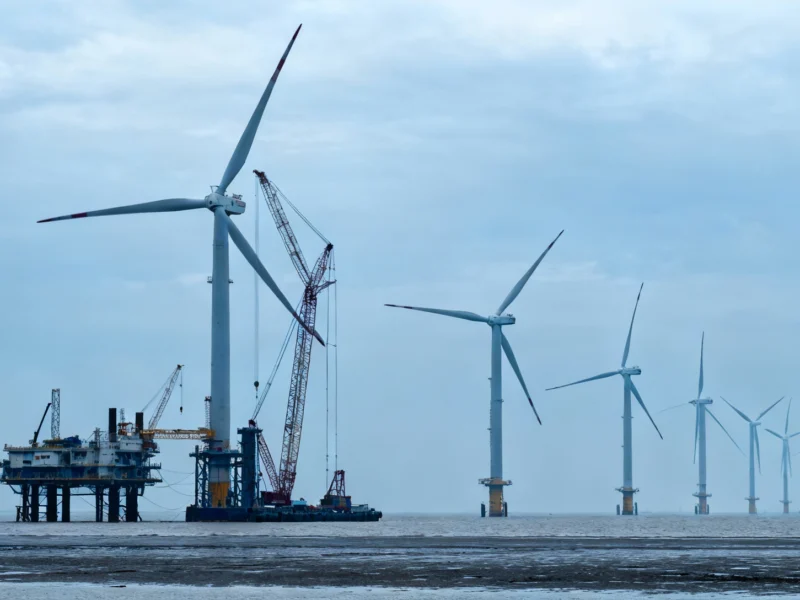Industry Leader Faces Significant Setbacks
Danish renewable energy giant Orsted is implementing dramatic cutbacks, with sources indicating the company will eliminate 2,000 positions over the next two years. According to reports, this represents approximately 25% of the company’s global workforce and signals a major strategic shift for the once-dominant offshore wind developer.
The company’s president and chief executive, Rasmus Errboe, reportedly stated that Orsted was “narrowing its focus and dialing back its aspirations” in response to current market conditions. Analysts suggest the company will now concentrate primarily on completing existing projects rather than pursuing new wind farm developments globally.
Broader Industry Challenges
The offshore wind sector is experiencing a broad downturn, according to industry analysts. Reports indicate that rising construction costs and interest rates following the pandemic have created significant headwinds for developers. These challenges have been exacerbated by policy uncertainty under the Trump administration, which has taken several steps to curb offshore wind power development in the United States.
Energy consulting firm Wood Mackenzie reportedly forecasts that less than 50% of the cumulative targets set by national governments for offshore wind capacity by the end of the decade will be achieved, excluding China. “I think, in terms of electrification, there are certainly warning signs,” said Anders Kronborg, senior economist at Copenhagen Economics, according to the report.
US Market Uncertainty
The Trump administration’s intervention in US offshore wind projects has created significant uncertainty, sources indicate. The administration reportedly halted construction on two wind farms off the East Coast, though it later allowed one project to proceed and a federal judge permitted another nearly completed Orsted project to continue.
According to Anders Schelde, chief financial officer of Danish pension fund AkademikerPension, “In the coming years, nobody will start any new projects in offshore wind in the U.S.” He added that the situation would “probably also have some impact on other renewables,” according to the report.
This development comes amid broader market movements as banking stocks show divergence and international energy dynamics shift, with reported commitments to halting Russian oil imports creating new global energy alignments.
Impact on Danish Economy and Supply Chain
The reshaping of Orsted is having ripple effects across Denmark, where approximately 33,000 people work in the wind industry, according to industry group Green Power Denmark. Reports indicate that 235 of the 500 layoffs planned for this quarter will occur in Denmark.
Welcon, a Danish manufacturer that produces wind turbine towers, is reportedly supplying Orsted’s US projects but doesn’t expect new American business. “I don’t believe in the U.S. before we have a new president,” said Carsten Pedersen, the company’s chairman, according to the report.
The situation reflects broader technological and regulatory challenges affecting multiple sectors, similar to how Microsoft recently disabled one-click IE mode in Edge and as Meta and Arm forge partnerships to boost AI performance in the tech sector.
Government Support and Investor Response
The Danish government, which owns a majority of Orsted’s shares, has reportedly provided approximately $4.7 billion in a recent offering to shareholders to support the company and the wind industry. Some investors reportedly viewed this as an opportunity to buy into a leading renewable company at a discounted price, with Orsted’s share price down around 50% over the past year.
“In my view, this is a business that is going to be around,” said Charles Lemonides, founder of ValueWorks, a New York-based fund management company that increased its stake in Orsted to about $15 million, according to the report. “The world’s not using less electricity,” he added.
However, analysts suggest that Orsted is likely to be diminished as an instrument for expanding wind power in the coming years. “After these assets are built, they don’t really have any other live projects,” said Deepa Venkateswaran, a utility analyst at Bernstein, according to the report.
Broader Implications for Renewable Transition
The challenges facing Orsted and the offshore wind industry come at a critical time for global renewable energy development. According to trade body WindEurope, the wind industry employs roughly 370,000 people in Europe and accounts for around 20% of the region’s electricity generation.
Analysts suggest that recent developments, including rising costs and policy uncertainty, have prompted a reassessment of renewable energy goals set by the European Union and national authorities. The situation reflects the complex interplay between energy policy and economic realities, similar to how regulatory decisions in other sectors can create significant market impacts.
According to the report, the industry outlook beyond 2027 appears bleak, with Soeren Lassen, head of offshore wind at Wood Mackenzie, noting that “a lot of that volume was supposed to come in towards the end of the decade. That’s not the case anymore.”
This article aggregates information from publicly available sources. All trademarks and copyrights belong to their respective owners.



